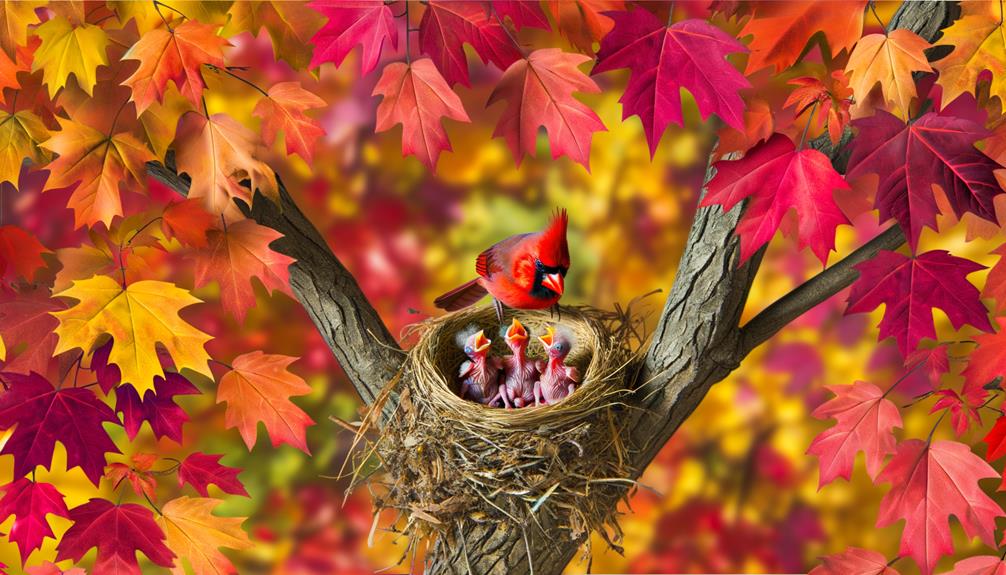Do Cardinals Have Babies in Fall?
Cardinals primarily breed in spring and summer, with nesting starting as early as March. Occasionally, you'll observe cardinals having babies in the fall.
Warmer autumns, ample food supply, and lower predator activity can extend their breeding. Typically, female cardinals lay 2-5 eggs per clutch, with an 11-13 day incubation period.
Nesting in dense shrubs or low tree branches provides protection. Adaptations to environmental conditions can trigger fall nesting.
Observations and expert studies suggest this behavior, while rare, is a fascinating aspect of cardinal life. Curious about the intricate details of their breeding habits?

Key Takeaways
- Cardinals can nest in the fall due to warmer autumns extending the breeding season.
- Fall nesting may occur when there is an abundance of food sources.
- Lower predator activity in the fall can promote safer conditions for raising young.
- Fall nesting in cardinals is atypical but documented by ornithologists.
- Environmental conditions can trigger fall nesting as an adaptive behavior.
Cardinal Breeding Habits
Cardinal breeding habits reveal a preference for nesting during the spring and early summer months, supported by extensive observational data.
You'll notice that cardinals often choose dense shrubs or low tree branches for their nests, which offer protection from predators and harsh weather.
Studies show that male cardinals actively participate in feeding and protecting the young, while females focus on nest building and incubation.
Observations indicate that cardinals usually lay 2-5 eggs per clutch, with an incubation period of approximately 11-13 days.
After hatching, the fledglings remain in the nest for about 9-11 days before they're ready to leave.
This breeding behavior ensures higher survival rates for the offspring during ideal environmental conditions.
Typical Nesting Seasons
You'll find that cardinals primarily breed in the spring, with evidence showing their first nesting attempts as early as March.
Observations indicate that they may continue nesting into the summer, often producing multiple broods during this period.
Research supports that their nesting habits are closely tied to seasonal changes and food availability.
Spring Breeding Cycle
Observing the typical nesting seasons, you'll find that Northern Cardinals primarily breed in the spring, with peak activity occurring from March through May. During this period, males perform elaborate songs to attract mates and establish territories. Females then construct nests using twigs, grass, and other materials.
The following table provides more insight into the spring breeding cycle:
| Phase | Description |
|---|---|
| Courtship | Males sing and display vibrant plumage |
| Nest Building | Females gather materials and construct nests |
| Egg Laying | Females lay 3-4 eggs per clutch |
| Incubation | Lasts around 11-13 days, primarily by females |
This cyclic pattern ensures ideal conditions for raising their young, leveraging abundant food resources and favorable weather.
Summer Nesting Habits
Moving from spring into summer, Northern Cardinals continue their breeding activities, often initiating a second or even third nesting cycle during June through August.
You'll notice that they prefer dense shrubs or low tree branches for nest sites, providing concealment and protection.
Female cardinals typically lay 2-5 eggs per clutch, which hatch after about 11-13 days of incubation. Both parents actively participate in feeding the nestlings, with fledging occurring around 9-10 days post-hatching.
Research indicates that cardinals' high reproductive rate during the summer secures species survival, despite predation risks.
Nest Construction
Cardinals carefully construct their nests using a combination of twigs, leaves, and grasses, often choosing dense shrubs or low tree branches for ideal concealment and protection.
You'll notice that they weave these materials together with remarkable precision, creating a stable structure. They line the interior with softer materials like pine needles or animal hair to provide a cozy environment for their eggs.
Research shows that cardinals prefer sites with abundant foliage, minimizing predation risks. The female mainly builds the nest, taking about 3 to 9 days to complete it.
Observational studies indicate that the selected locations are typically 1-15 feet above ground, offering both accessibility and safety from ground predators. This systematic approach ensures peak conditions for their offspring.
Mating Rituals
Frequently seen during the spring and early summer, the mating rituals of cardinals are complex displays involving courtship feeding, song duets, and synchronized movements.
You'll observe males feeding females seeds, a behavior that strengthens pair bonds. Their song duets, where males and females sing in harmony, serve both to attract mates and ward off rivals.
Synchronized movements, such as hopping in unison, further solidify their connection.
Key elements include:
- Courtship Feeding: Males provide food to females, demonstrating their ability to be good providers.
- Song Duets: Coordinated singing that helps establish territory and attract a mate.
- Synchronized Movements: Physical displays that enhance bonding and communication.
These rituals are critical for successful mating and partnership formation.
Egg Laying Patterns
You'll observe that cardinals primarily lay eggs during the spring and early summer, aligning with their seasonal breeding habits.
They prefer nesting sites in dense shrubbery or low tree branches, providing ideal protection and resources.
Studies show that these choices increase hatchling survival rates greatly.
Seasonal Breeding Habits
During the spring and early summer, you'll observe that Northern Cardinals typically lay their eggs, with the peak breeding season occurring from March through July. Their breeding habits are influenced by environmental factors and biological rhythms.
Cardinals usually have multiple broods per season, and you can expect them to lay eggs in intervals of approximately 10-14 days.
Here are the key patterns observed:
- Breeding Frequency: Cardinals often have 2-3 broods per season.
- Clutch Size: Each clutch generally contains 2-5 eggs.
- Incubation Period: The eggs incubate for about 11-13 days before hatching.
These patterns are consistent across their range, ensuring successful reproduction and growth of the cardinal population. Understanding these habits helps you better appreciate their reproductive strategies.
Nesting Site Preferences
Understanding the Northern Cardinals' nesting site preferences is crucial for comprehending their egg-laying patterns in different habitats.
You'll notice that cardinals prefer dense shrubs or low tree branches, offering concealment from predators. They often choose sites 1-15 feet above the ground, ensuring safety and accessibility.
Research indicates that cardinals exhibit a preference for nesting in areas with abundant foliage, providing a stable microenvironment for egg incubation.
You might observe that they lay eggs primarily in spring and summer, but under ideal conditions, they can extend into early fall. The clutch size typically ranges from 2-5 eggs, and the female incubates them for about 11-13 days.
Recognizing these preferences helps explain their adaptive strategies across various seasons and environments.
Seasonal Influences
Cardinals' breeding patterns are greatly influenced by seasonal changes, with the majority of their nesting activities occurring in the spring and summer months. These seasons provide ideal conditions for reproductive success.
You'll notice several key factors at play:
- Temperature: Warmer temperatures in spring and summer create a favorable environment for egg incubation and chick development.
- Food Availability: An abundance of food sources, such as insects and seeds, ensures that parents can adequately nourish their young.
- Daylight Hours: Longer days allow more time for foraging, which is essential for meeting the high nutritional demands of growing chicks.
Fall Nesting Observations
Observations indicate that while it's rare, some cardinals do engage in nesting activities during the fall. You might notice that these birds exhibit courtship behaviors such as singing and mate-feeding.
Fall nesting often occurs when environmental conditions, like unseasonably warm weather and abundant food supplies, mimic those of spring. You'll see both males and females participating in nest building, often choosing dense shrubs or low tree branches.
Eggs laid during fall tend to have lower survival rates due to changing weather conditions and reduced insect availability. Documenting these instances requires careful monitoring and consistent data collection, providing valuable insight into the adaptability and reproductive strategies of cardinals.
Such observations expand our understanding of avian breeding cycles.
Expert Opinions
Leading ornithologists suggest that while fall nesting in cardinals is atypical, it represents a fascinating adaptation to fluctuating environmental conditions. Their observations indicate that certain conditions can trigger this unusual behavior.
For instance:
- Climate Change: Warmer autumns can extend the breeding season, prompting cardinals to nest later.
- Food Availability: An abundance of food sources in the fall can support additional broods.
- Predator Patterns: Lower predator activity in the fall might create a safer environment for raising young.
Experts base these conclusions on detailed field studies and long-term data collection. They emphasize that understanding these adaptive behaviors helps in conservation efforts, ensuring that these vibrant birds continue to thrive despite changing ecological landscapes.
Supporting the Cardinals
Recognizing the adaptability of cardinals to changing conditions, you can play a significant role in supporting their populations through simple, evidence-based actions. Provide a consistent food supply by installing feeders with black oil sunflower seeds, a favorite among cardinals.
Make sure fresh water is available for drinking and bathing, as hydration is essential year-round.
Plant native shrubs and trees that offer natural food sources and nesting sites, like dogwood and serviceberry. Avoid using pesticides, which can harm cardinals and reduce insect availability.
Maintaining a habitat with dense vegetation can protect cardinals from predators and harsh weather. By taking these steps, you'll create a supportive environment, aiding in the survival and reproduction of this resilient bird species.
Conclusion
While you might think cardinals only breed in spring, evidence shows they can also have babies in the fall. Detailed observations reveal that some cardinals construct nests and lay eggs well into autumn.
Researchers note factors like mild weather and abundant food supplies can influence this extended breeding season. Don't dismiss fall nesting; it's a fascinating adaptation that guarantees the survival of these vibrant birds.
Supporting cardinals year-round can help bolster their population.






